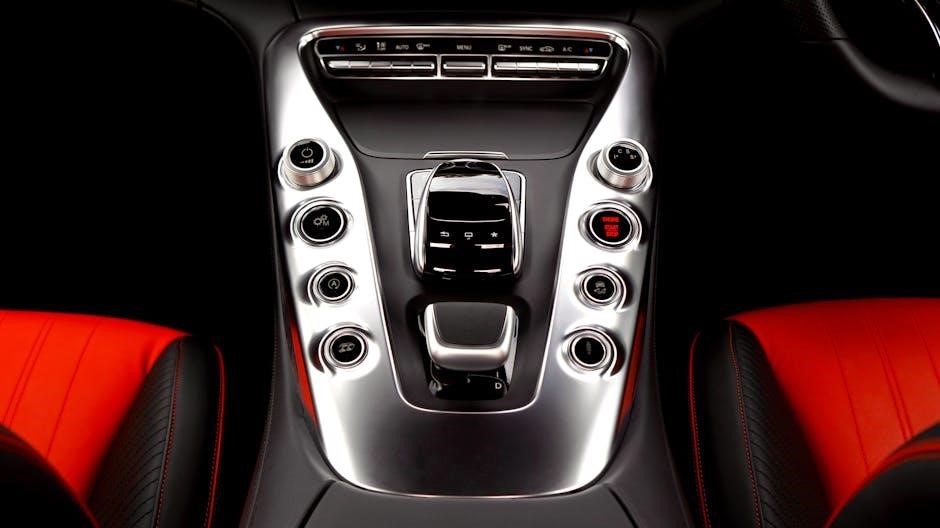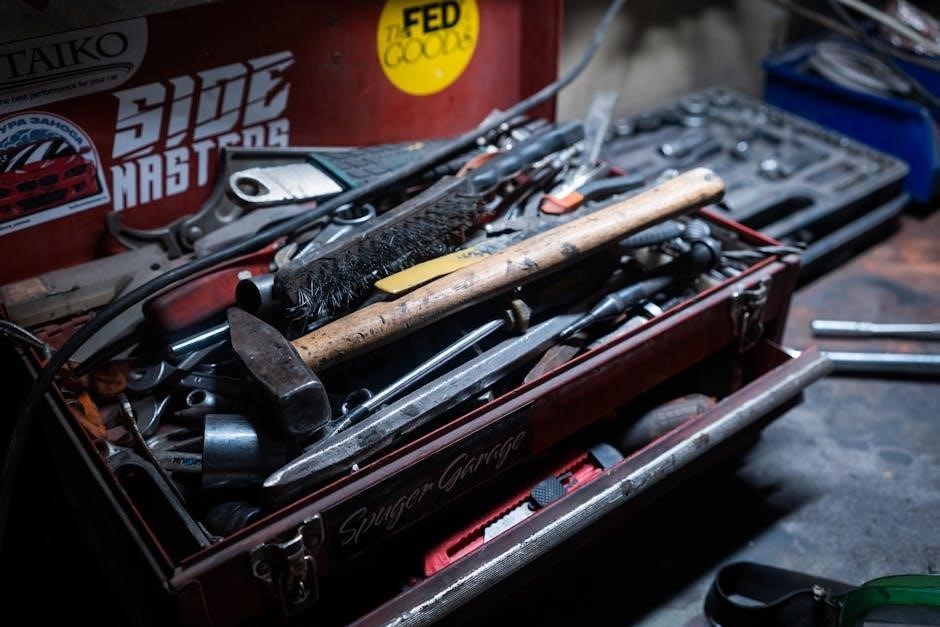The choice between manual and automatic cars is a fundamental decision for drivers․ Each offers a distinct driving experience and set of advantages․
Overview of Transmission Types
Manual transmissions‚ also known as stick shifts‚ require the driver to manually engage gears using a clutch pedal and gear shifter․ The driver controls gear selection based on speed and torque demands․ This direct connection provides a more engaging and involved driving experience‚ favored by enthusiasts who appreciate control․ Manual transmissions have a gearbox with a set number of gears․ Smooth shifting requires coordinating the clutch pedal and shifter․ While traditionally offering better fuel economy due to the driver’s ability to select optimal gears‚ this advantage has narrowed with advancements in automatic technology․ Manual cars have fewer complex components‚ potentially leading to lower maintenance costs․ However‚ they can be less convenient in stop-and-go traffic‚ requiring constant clutch and gear engagement․ Learning to drive a manual is a valuable skill‚ but automatics are increasingly popular․

Driving Experience
The driving experience is a key factor when choosing between a manual and an automatic car‚ offering distinct sensations․
Manual: Control and Engagement
Manual transmissions offer drivers a heightened sense of control and engagement․ The direct connection between the engine and wheels allows for precise gear selection based on road conditions‚ optimizing performance and providing a more interactive driving experience․ Shifting gears manually requires coordination between the clutch pedal and gear shifter‚ a process that many driving enthusiasts find rewarding․ The ability to control acceleration and torque manually adds to the thrill of driving‚ making it a preferred option for those who value performance․ Drivers can choose the best gear to optimize efficiency‚ keeping RPMs low and fuel consumption in check (though modern automatics are closing this gap)․ The hands-on nature of a manual transmission is essential for some drivers‚ providing a feeling of being more connected to the car and the road․ Learning to drive a manual car can be a valuable skill‚ providing a deeper understanding of how a car operates and offering a sense of accomplishment․
Automatic: Convenience and Ease of Use
Automatic transmissions prioritize convenience and ease of use‚ shifting gears automatically without driver intervention․ This simplifies the driving experience‚ particularly in stop-and-go traffic‚ as drivers only need to control the accelerator and brake pedals․ Automatic vehicles are widely popular for their convenience and reduced driver effort․ Modern automatic transmissions feature adaptive transmission control and CVT technology‚ optimizing gear ratios for better fuel economy and smoother transitions․ Dual-clutch transmissions (DCTs) and CVTs offer lightning-fast gear shifts‚ often quicker than a human can achieve manually‚ maximizing acceleration and responsiveness in sports cars․ The effortless performance of an automatic transmission is appreciated by many drivers‚ especially in daily commutes and long journeys․ Automatic transmissions have come a long way‚ offering benefits such as smooth gear changes and reduced driver fatigue․ The increasing popularity of automatic cars reflects a preference for convenience and ease of operation․ Modern automatic transmissions offer a strong alternative to manuals‚ combining ease of use with improved performance and fuel efficiency․

Fuel Efficiency
Fuel efficiency is a key consideration when choosing between manual and automatic cars‚ with historical and modern factors at play․
Historical Differences
Historically‚ manual transmissions held a distinct advantage in fuel efficiency; This stemmed from their direct mechanical connection between the engine and the wheels‚ allowing drivers to select the optimal gear for any given driving condition․ Skilled drivers could leverage this control to maintain lower engine RPMs‚ minimizing fuel consumption․ Automatic transmissions‚ in contrast‚ relied on torque converters‚ which introduced some slippage and inefficiency․ This resulted in higher fuel consumption compared to their manual counterparts․ The difference was noticeable and often a significant factor for budget-conscious car buyers․ Manual cars were often perceived as the more economical choice‚ especially for long-distance driving or city commutes where fuel efficiency was paramount․ This perception was further reinforced by the simpler mechanical design of manual transmissions‚ which contributed to lower maintenance costs and a longer lifespan․ As a result‚ manual cars were a popular option for those prioritizing fuel savings and reliability․ However‚ technological advancements in automatic transmissions have dramatically narrowed this gap over time․ Modern automatics now incorporate features like adaptive transmission control and continuously variable transmissions (CVTs)‚ challenging the traditional fuel efficiency advantage of manual cars․
Modern Automatic Transmissions
Modern automatic transmissions have undergone a significant evolution‚ effectively addressing the historical fuel efficiency gap with manual transmissions․ These advancements include sophisticated technologies like adaptive transmission control‚ which dynamically adjusts gear ratios based on driving conditions and driver behavior‚ optimizing fuel consumption in real-time․ Continuously Variable Transmissions (CVTs) represent another leap forward‚ offering a seamless and virtually infinite range of gear ratios to keep the engine operating at its most efficient point․ Furthermore‚ modern automatics often incorporate features like lock-up torque converters‚ which eliminate slippage at higher speeds‚ further enhancing fuel economy․ Dual-clutch transmissions (DCTs) combine the convenience of an automatic with the speed and efficiency of a manual‚ offering rapid gear changes and minimal power loss․ In some cases‚ these advanced automatic transmissions can even surpass the fuel efficiency of manual cars‚ particularly in specific driving scenarios․ This is especially true in urban environments with frequent stop-and-go traffic‚ where the automatic’s ability to smoothly and efficiently manage gear changes can provide a distinct advantage․ Consequently‚ the fuel efficiency landscape has shifted‚ making modern automatics a compelling choice for drivers seeking both convenience and economy․ The best option truly depends on the specific car‚ driving habits‚ and the technological advancements incorporated into the transmission design․

Maintenance and Repair Costs
The cost of maintaining and repairing a car depends on whether it has a manual or automatic transmission system․
Manual: Simplicity and Lower Costs
Manual transmissions‚ often referred to as “stick shifts‚” are known for their relatively simple mechanical design․ This inherent simplicity translates to several advantages when it comes to maintenance and repair costs․ With fewer complex components compared to automatic transmissions‚ there are fewer parts that can potentially fail․ This reduces the likelihood of breakdowns and the need for extensive repairs․ The straightforward nature of manual transmissions also makes them easier for mechanics to diagnose and repair‚ which can result in lower labor costs․ Furthermore‚ replacement parts for manual transmissions are generally more affordable than those for automatics‚ further contributing to the overall cost savings․ This makes manual cars a potentially more economical choice for those concerned about long-term maintenance expenses․ However‚ as with any mechanical system‚ regular maintenance such as clutch adjustments and fluid checks is still essential to ensure the longevity and optimal performance of a manual transmission․ Neglecting these routine tasks can lead to premature wear and tear‚ potentially resulting in more costly repairs down the line․ In conclusion‚ the simplicity of manual transmissions typically translates to lower maintenance and repair costs‚ making them an attractive option for budget-conscious car owners‚ provided that regular maintenance is performed to prevent major issues․
Automatic: Complexity and Potential Higher Costs
Automatic transmissions‚ while offering convenience and ease of use‚ are inherently more complex mechanical systems compared to their manual counterparts․ This complexity stems from the intricate network of hydraulic systems‚ sensors‚ and electronic controls that govern gear shifting․ The increased number of components and their sophisticated interactions contribute to a higher potential for malfunctions and breakdowns․ Consequently‚ when issues arise with an automatic transmission‚ the repair process can be more involved and require specialized diagnostic equipment․ This often translates to higher labor costs‚ as mechanics need to spend more time identifying and resolving the problem․ Furthermore‚ replacement parts for automatic transmissions tend to be more expensive than those for manual transmissions‚ further adding to the overall repair bill․ While modern automatic transmissions are generally reliable‚ their complexity makes them more susceptible to certain types of failures‚ such as issues with the torque converter‚ valve body‚ or electronic control unit․ These components can be costly to repair or replace‚ potentially leading to significant expenses․ Moreover‚ automatic transmissions require specialized fluids that need to be changed at regular intervals to ensure proper lubrication and cooling․ Neglecting these fluid changes can accelerate wear and tear‚ increasing the risk of costly repairs․ In summary‚ the complexity of automatic transmissions can lead to potentially higher maintenance and repair costs compared to manual transmissions‚ making it important to factor in these long-term expenses when choosing a vehicle․ Regular maintenance and timely repairs are crucial to minimize the risk of major issues and extend the lifespan of an automatic transmission․
Purchase Price
The initial cost is a key factor․ Manual cars typically have a lower sticker price‚ making them accessible to budget-conscious buyers․
Manual: Generally More Affordable
Manual transmission vehicles typically come with a lower initial purchase price compared to their automatic counterparts․ This affordability stems from their simpler mechanical design‚ which translates to lower manufacturing costs․ The absence of complex components like torque converters and sophisticated electronic control units reduces the overall expense of producing a manual car․ This cost-effectiveness is often passed on to the consumer‚ making manual cars an attractive option for budget-conscious buyers or those seeking an entry-level vehicle․ For individuals prioritizing affordability‚ the lower purchase price of a manual car can be a significant advantage‚ allowing them to allocate their resources to other essential expenses or upgrades․ Furthermore‚ the reduced complexity of manual transmissions often leads to lower insurance premiums‚ further contributing to the overall cost savings associated with owning a manual vehicle․ The readily available parts and straightforward repair procedures also contribute to the long-term affordability of maintaining a manual car‚ making it a financially sound choice for those seeking a reliable and budget-friendly transportation option․ This price difference can be substantial‚ particularly for new cars‚ making manual transmissions a compelling option for first-time car buyers‚ students‚ or anyone looking to minimize their upfront investment in a vehicle․ While the price gap may narrow in the used car market‚ manual transmissions generally retain their advantage in terms of affordability․
Automatic: Higher Initial Investment
Automatic transmission vehicles generally command a higher initial purchase price compared to their manual counterparts․ This increased cost is primarily attributed to the greater complexity of automatic transmissions‚ which involve sophisticated engineering and intricate components․ Automatic transmissions utilize advanced technologies such as torque converters‚ planetary gear sets‚ and electronic control systems to seamlessly shift gears without driver intervention․ These complex systems require more expensive materials‚ precision manufacturing processes‚ and extensive calibration‚ all of which contribute to the higher production costs․ Furthermore‚ the research and development invested in designing and refining automatic transmissions adds to the overall expense‚ which is ultimately reflected in the vehicle’s price tag․ For consumers on a tight budget‚ the higher initial investment required for an automatic car can be a significant barrier to entry․ However‚ many buyers are willing to pay the premium for the added convenience and ease of use that automatic transmissions provide‚ particularly in urban environments with heavy traffic congestion․ The increasing demand for automatic vehicles has also contributed to their higher price point‚ as manufacturers prioritize production and development efforts towards this popular transmission type․ While the long-term maintenance costs of automatic transmissions may be higher in some cases‚ the initial investment remains a key consideration for potential buyers weighing the pros and cons of manual versus automatic cars․ Despite the higher price‚ the smooth and effortless driving experience offered by automatic transmissions continues to attract a large segment of the car-buying market‚ justifying the premium for many consumers․

Popularity and Market Trends
The automotive market has seen a significant shift in consumer preferences regarding transmission types over the past few decades․
Decline of Manual Transmissions
Manual transmissions‚ once a dominant force in the automotive landscape‚ have experienced a noticeable decline in popularity over recent years․ Several factors contribute to this trend‚ including the increasing convenience and sophistication of automatic transmissions‚ shifting consumer preferences‚ and the demands of modern driving conditions․ Automatic transmissions offer ease of use‚ especially in congested urban environments‚ where frequent stop-and-go traffic can make driving a manual car tedious․ Furthermore‚ advancements in automatic transmission technology‚ such as adaptive transmission control and continuously variable transmissions (CVTs)‚ have significantly improved fuel efficiency‚ closing the gap with manual transmissions․ As a result‚ many drivers no longer perceive a significant advantage in choosing a manual car․ The availability of advanced features like paddle shifters in automatic cars also provides drivers with a degree of control that was previously exclusive to manual transmissions‚ further eroding the appeal of stick shifts․ The decline in manual transmission sales reflects a broader trend towards convenience and ease of use in modern vehicles‚ as manufacturers prioritize features that cater to the majority of drivers․ This trend is expected to continue as automatic transmissions become even more sophisticated and integrated with advanced driver-assistance systems (ADAS)․
Increasing Popularity of Automatic Cars
The rise in popularity of automatic cars is a direct consequence of advancements in technology and evolving consumer preferences․ Modern automatic transmissions offer a seamless and effortless driving experience‚ particularly appealing in today’s fast-paced and often congested urban environments․ The convenience of automatic shifting allows drivers to focus more on navigating traffic and less on the mechanics of driving‚ reducing driver fatigue and enhancing overall safety․ Moreover‚ automatic transmissions have made significant strides in fuel efficiency‚ thanks to features like adaptive transmission control‚ continuously variable transmissions (CVTs)‚ and dual-clutch transmissions (DCTs)․ These technologies optimize gear ratios for improved fuel economy‚ often rivaling or even surpassing that of manual transmissions․ The integration of automatic transmissions with advanced driver-assistance systems (ADAS) further enhances their appeal‚ as these systems often rely on the smooth and predictable shifting of automatic gearboxes to function effectively․ Paddle shifters‚ which allow drivers to manually select gears in an automatic car‚ offer a compromise between the convenience of automatic shifting and the control of a manual transmission‚ appealing to a wider range of drivers․ The increasing availability of automatic transmissions in a variety of vehicle types‚ from economy cars to high-performance sports cars‚ also contributes to their popularity‚ as manufacturers cater to the growing demand for convenience and ease of use․ As technology continues to advance‚ automatic transmissions are poised to become even more prevalent in the automotive market․
